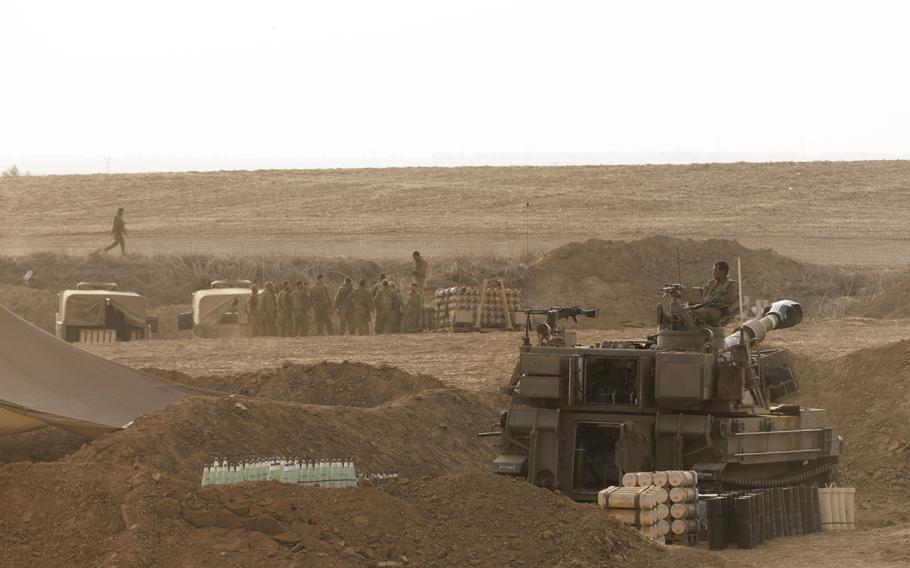
An Israeli army mobile howitzer dug in near the border with the Gaza Strip outside Kibbutz Be’eri in southern Israel, on Oct. 22, 2023. (Kobi Wolf/Bloomberg)
In October 1973, after Israeli forces had pushed the Syrian army back from the Golan Heights, Israeli air force commander Gen. Benny Peled stated, “Advance to within artillery range of Damascus. The only thing that can bring about a cease-fire is if our shells hit inside the city.” In 1973, however, despite the bombing of Syrian army General Staff Headquarters, there was no attempt to take Damascus on the ground. Israel, however, was able to use the artillery threat to get better terms for the cease-fire.
Fifty years later, Israel is employing airpower and artillery on a large scale in its war against Hamas. There are many significant differences with 1973, however, as Israel is fighting a non-state terrorist organization, and Israel’s goals are more ambitious. Israeli Defense Minister Yoav Gallant said, “We will wipe this thing called Hamas, ISIS-Gaza, off the face of the Earth.” This call for total annihilation of the adversary has led to the use of concentrated heavy firepower in Gaza.
The Israeli army has traditionally been a force with a preference for armored warfare. Years of counterinsurgency and counterterrorism operations, however, led to a disillusion about the prospects for mechanized victory against Israel’s adversaries, especially after the conflict with Hezbollah in 2006. Recent doctrinal changes since 2019, however, have refocused Israeli strategy around conventional “swift, offensive operations relying on the use of smaller units supported by massive firepower.” This strategic concept, “Decisive Victory,” was launched officially in January 2020. It also envisioned a war on multiple fronts. An important change was the definition of terrorist groups as “rocket-based terror armies.” By using this definition instead of asymmetry, the Israel Defense Forces effectively removed the limits on what type of force could be used in a conflict.
The first phases of the conflict in Gaza reflected the Israeli Decisive Victory doctrine. The Israeli air force struck Gaza from the air to destroy Hamas infrastructure and leadership. In Israeli doctrine, this involves the detection of targets using sensors, and the destruction of the sources of rocket fire. The IDF assumes that Hamas (and Hezbollah) are defensively-oriented military forces based on firepower. Airpower also provided the means to reduce the threat to ground forces by reducing the defensive positions around the limited entrances to Gaza. As demonstrated in the war in Gaza in 2014, however, the effectiveness of airpower is limited in that it was not able to decisively destroy Hamas’ tunnel network.
Artillery has also been used extensively in preparing the battlefield for ground operations in Gaza. On Oct. 12, there were reports of Israeli 150 mm cannons firing into Gaza from Sderot every 30 seconds. By Nov. 2, Israel had hit Gaza City with more than 10,000 munitions. Israel is quickly depleting its stocks of ammunition, however, and a certain number of bombs (including the GPS-guided JDAM) and 155 mm artillery shells will likely be supplied through shipments from the U.S.
The long campaign of bombing and shelling prior to the ground attack in early November resembled in some ways the large-scale artillery barrages prior to offensives in World War I. It also highlights a departure from the Decisive Victory strategy, in that Israel set the stage for a long siege. The main difference from the WWI battlefield, however, is that the Gaza Strip is one of the most densely-populated areas on Earth. This will likely result in a number of tactical and strategic problems.
One of the primary tactical problems is the inability of heavy firepower to destroy underground tunnel networks. A related problem is the likely ability of Hamas fighters to dig into the ruins of buildings destroyed by bombing. A number of instances from World War II illustrate this problem clearly, notably the occupation and fortification by German troops of the ruins of the monastery of Monte Cassino after its destruction by allied bombing.
The major strategic problem for Israel is that while, contrary to the Decisive Victory doctrine, it is preparing for a long war, international pressure may stop it. The U.S. has been reluctant to call for a cease-fire, but increasing civilian casualties may eventually lead it to change its approach. [Israel and Hamas agreed early Wednesday to a four-day pause in fighting as part of a hostage release deal.] Israel may be attempting through heavy firepower to inflict as much damage on Hamas as possible before it is forced to terminate operations. Similarly in October 1973, Israel raced to complete operations before a superpower-imposed cease-fire.
The U.S. would be well-advised to consider the key link between international opinion and operational concepts that is playing out in the Israel-Hamas war. A terrorist group can be attacked and defeated using conventional firepower. Using airpower and artillery against an entrenched terrorist group in a heavily-populated urban area, however, will likely lead to widespread international opposition, which could limit the time needed to achieve a decisive military result.
Christopher Griffin is an associate professor at the Université Catholique de l’Ouest in Nantes, France, where he is the Head of Department for Applied Foreign Languages and Head of International Programs for the Nantes Campus.